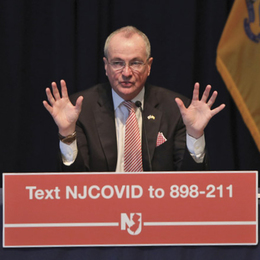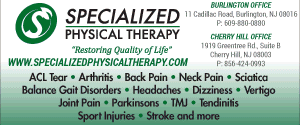
A Work in Progress
Gov. Phil Murphy on his handling of the pandemic thus far and what still needs to be done in order for New Jersey to regain its footing.
With the exception of New York, no other state has been ravaged by the COVID-19 pandemic like New Jersey. With a reported 155,765 cases and 11,191 deaths as of press time, the Garden State has been at the forefront of America’s coronavirus battle. Leading the charge has been Gov. Phil Murphy, who issued a statewide stay-at-home order on March 21, in turn shuttering non-essential businesses, prohibiting mass gatherings and ushering in a lengthy list of restrictions.
As the days turned into weeks and the weeks into now months, Murphy has received both praise for his leadership and criticism for his lack of concrete details with regard to the state’s plan for reopening. As New Jersey continued to see the curve flattened, the governor preached patience and repeatedly used the phrases “data determines dates” and “public health creates economic health.” While several polls suggest that a majority of residents support Murphy’s handling of the pandemic, lawmakers from both sides of the aisle along with several business owners crippled by the shutdown have continuously pleaded for information that would provide light at the end of the tunnel.
In mid-May, Murphy finally began to fill in some of the blanks. Some restrictions were rolled back to allow more businesses to begin operating again with certain safeguards put into place and outdoor activities like walking in the park, teeing off at the golf course or heading to the Shore were also given the green light.
The governor also introduced a new multi-phase approach that outlined certain criteria and benchmarks that needed to be met before further progress could be made. Dubbed “The Road Back,” the five-stage plan gradually loosens restrictions, but each step of the way will be carefully dictated by the data Murphy has relied so heavily on to this point and is not tied to any particular timeframe.
“We must remain vigilant. We will not risk lives to a rebound of COVID-19. The protocols that will get us to the new normal—social distancing, proper sanitation and hygiene, face coverings, a strong program of testing and contact tracing, and personal responsibility and compliance—are what will allow us to thrive once we get there,” the governor said during his May 18 coronavirus briefing.
Just hours after making his announcement on how to reopen New Jersey, we spoke with Gov. Murphy to gain some insight into how he’s managed this crisis and why he stands by the decisions he’s made, no matter how popular or unpopular they have been. And while he’s certainly been very visible during this whole ordeal, we wanted to find out what those private moments away from the public eye have been like for him as he tries to navigate a state of nearly 9 million people through this unprecedented situation.
Throughout this week, you’ve relaxed some restrictions and provided some definitive ways that certain businesses and industries can reopen and operate. You received some initial criticism for unveiling a broad recovery plan without concrete specifics, but you were steadfast that you wouldn’t be influenced by outside noise and that it would take time to get this right. How did you try and balance being cognizant of the struggles that are taking place with listening to your team of experts, your colleagues and your constituents?
Not to repeat something that I’ve said every step of the way, but we try to make every call we make based on the facts as opposed to being based on some notion or some pressure as a general matter. And I’m not being holier than thou; I can’t tell you we always get it right, but we certainly try to get it right.
We said right from the get go if the health metrics—the curves we watch—started moving meaningfully in the right direction, it would allow us to take steps to start to reopen. And we have a phrase we believe in: “Public health creates economic health.” We believe that. That doesn’t mean for one second that we don’t know or don’t accept how devastating the economic impact has been. What it really says is, unless we knock the virus out as best we can and have a health care infrastructure in place to spot it if it comes back, then there won’t be the confidence we need to reopen the economy. And if we did it the other way around and just let the economy run, we would have had far more infections and hospitalizations and a far bigger economic reality.
Again, I’m not patting myself on the back saying we always get this right, but that’s the order of events and basing decisions on facts has been not just our approach, but it has allowed me and my team the ability to stay as focused as we’ve been.
I have been very touched by a lot of people. I want to give the mayors a particular shout out because like a governor, they are the chief executive. I’ve gotten some really thoughtful, responsible input from many folks, but in particular mayors.
I think we just keep calling things as we see them, based on the facts. God, I would love to open this place up wide more than anybody. But we’ve got to do it responsibly.
The northern part of the state was obviously rocked hard with the majority of the reported cases and deaths. The most recent numbers show that new hospitalizations and new discharges are now not that far off from one another across the state. Did that weigh into the decision to take the statewide approach to reopening things as opposed to regionally?
Yes, it did. First of all [the virus] clobbered metro New York and that included northern Jersey; in particular the big six commuting counties (Bergen, Hudon, Essex, Union, Passaic and Middlesex) got clobbered. But, we always said it was going to migrate. My concern was that in South Jersey, even though there are fewer people there, there’s also less health care infrastructure per capita there. My fear was as it migrated down it could’ve overwhelmed the south. And thank God—I’m knocking on wood here as I say this—it has not. It was still climbing seven to 10 days ago in terms of hospitalizations, but it has flattened and each day it has stayed within a manageable number.
That’s a long way of saying I think we can continue to make decisions statewide, but [New Jersey Department of Health Commissioner] Judy Persichilli had managed this as a regional manner and I think that was exactly the right thing to do. And so you had Kevin O’Dowd [co-president and CEO] at Cooper [University Health Care], who was not just running Cooper, but he was our coordinator for the south if we had to divert, if we had to use the field medical stations, move patients around, etc. We had the same analogy in central and in the north and that turned out to be a smart move by [Persichilli] and [O’Dowd] did a great job and continues to.
In early March you had cancer surgery and instead of taking some time to really recover, you were thrust into dealing with the pandemic. So, I’m just curious to know how you are doing; how’s your health these days?
You’re great to ask, man. I had kidney surgery, which turned out to be a malignant tumor on March 4. That was also the day of our first positive test in the state, so I found out about that as they rolled me back into my room.
Mike Tyson has that great line: “Everyone’s got a plan until they get punched in the face.” I had a plan to spend three days in the hospital, which I did do, and then 10 days working from home. I got about halfway through that and the whole thing was thrown out the window. But thank God, as I sit here today with you right now, I feel good. I went for a run this morning and I feel good. It’s not how I expected it to be, but I’m hanging in.
An unprecedented crisis like this certainly tests one leadership, but on a personal level how are you coping with this? What is life like when you are finally able to get a moment to yourself away from the cameras and the chaos?
I’m doing OK and I do find that my family is a big part of that. We’ve got four children, three in college and one in high school. They’ve all been remote learning since March. My wife, Tammy, is working full-time. Really, not just as First Lady, but she’s been helping to run the New Jersey Pandemic Relief Fund. And so, we get the six of us together more often than we ever would have.
If you look for a silver lining, the only guy who was at home was our high schooler; the other three were away, in some cases far away, at college. And they’ve been home and it’s the most amount of time the six of us have spent together in years.
You’ve talked a lot about this during your daily briefings and the like, but what does it say to you about the resolve that people across the state have shown and how they’ve come together? Whether it’s the first responders and the health care workers on the front lines to the families who are juggling virtual work with virtual learning to the people who have volunteered by sewing masks, donating personal protective equipment, donating food, etc.
It’s unbelievable, Jersey has stood so tall. We’ve lost over 10,000 people, let’s never forget that and let’s never forget each and every one of them. But at the same time, New Jersey has been unbelievable, north to south, from one line of work to another. Clearly, heroic health care workers, first responders, N.J. Transit bus drivers, rail operators, essential retail workers, police, fire, longshoremen, warehouse workers; I mean it’s unbelievable. And when you add to that everyone else that has done the right thing—we talk about the “knuckleheads,” but there just aren’t that many of them. Overwhelmingly, people have done the right thing and it’s extraordinary and it’s something that none of us should ever forget.
Though the curve has flattened and there’s hope that the next few months will continue that trend, there’s a threat the virus could rear its head in the fall and winter. Do you feel that the state is better prepared today than it was and are you hopeful that with that level of preparedness coupled with any possible therapeutics or other tools that may become available, that the situation we’ve all been going through since early March will not repeat itself to this extent?
I think so. I say that because we are clearly more prepared than we were a few months ago. We had started talking about this in January and I had put a task force together inside of government on Feb. 2. But the country, forget New Jersey, we were at a standing start. I don’t care why; let’s have the historians figure that out. And we do need a national as well as a state postmortem. But, we just weren’t ready as a country. We are, in New Jersey at least, a lot more ready, but not yet where we need to be.
I think you threw an important phrase into your question, which is therapeutics. If we get real—and I don’t mean, hey it works for malaria, let’s try it for COVID-19—I mean a FDA approved therapeutic explicitly for COVID, and then hopefully not too far down the road you get a vaccine, then that’s an accelerant in terms of how ready you can be. So we’re more ready, but not yet where we need to be or want to be and that’s a work in progress, I can tell you that right now. That’s part of the stuff we are doing every day, is to prepare for this if it rears itself again.
You are managing not only a public health crisis, but also a financial crisis as well. How do you think the $50 million in funding for small businesses through the CARES Act you recently announced will help reshape and re-shift the state’s economy?
You’ve got awful unemployment and incredible amounts of people suffering. You’ve then got small businesses that have been blown up. That $50 million we were able to take from the CARES Act and put it toward grants that the Economic Development Authority will execute; that’s a big deal. Small businesses have been crushed and it will help a lot. But, it’s not enough and that is the problem, so we need more federal support. We’ll do everything we can inside of New Jersey, but we need more federal support and we’ll stay on that.
Click here to subscribe to the free digital editions of South Jersey Magazine.
To read the digital edition of South Jersey Magazine, click here.
Published and copyrighted in South Jersey Magazine, Volume 17, Issue 3 (June 2020).
For more info on South Jersey Magazine, click here.
To subscribe to South Jersey Magazine, click here.
To advertise in South Jersey Magazine, click here.











